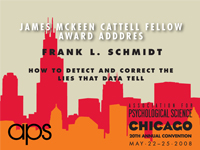Decision Making, Rationality, and Reasoning
Taking advantage of their overlapping annual meetings in Chicago, APS and the Association for Behavioral Analysis (ABA) jointly presented a symposium on “Decision Making, Rationality, and Reasoning: From Human to Animal,” showcasing some of the latest research on how (and why) animals and humans make certain decisions.

According to Allen Neuringer, Reed College, voluntary decision making is defined by one’s ability to behave in a predictable, semi-random, or totally random manner depending on the environment and/or the cues one receives. In an uncertain environment without a clearly superior option, one’s choices are made more or less according to chance. Once one receives positive reinforcement from a choice, it becomes the preferred option, as Neuringer proved in an experiment in which he rewarded rats whenever they changed their pattern of lever pressing. Neuringer has also shown that people this ability to respond randomly or predictably as a defining characteristic of human decision making. He discussed a previous experiment in which participants were asked to watch a simple game being played on a computer screen and to determine if the “player” was human or not. All the “players” were actually computer algorithms, but some were programmed to vary levels of predictability from random to fixed patterns, and the participants were in fact more likely to identify these “varying veritability” algorithms as human and label those that followed a noticeable pattern as artificial intelligence.
A certain amount of randomness may mark our decision making, but most of us try to make good choices based on potential future results. However, our predictions may sometimes be a little too rosy. As APS Fellow and Charter Member Peter Killeen, Arizona State University, noted in his talk, “People seem to discount the near future much too heavily.” Using a differential equation (which he described as “the mother of all discount functions”), Killeen illustrated how people often attach a current value to a future situation or outcome that looks inconsistent by bankers’ standards, but which makes sense when one recognizes that they are discounting utility, which is a concave function of dollar value. In a similar vein, Leonard Green, Washington University in St. Louis, discussed the process of “delay discounting” — the decreased subjective value that people place on delayed rewards. This process may account for why we often act impulsively, choosing smaller but sooner rewards rather than waiting for larger rewards. Green used pigeons and rats in his experiments to determine if the animals discount delayed food in the same fashion that his human participants discount delayed money. Although he noted that humans discount less steeply than do pigeons and rats, he found that both the animals and humans appear to use similar processes, and follow the same mathematical function, in decisions involving delayed rewards.

Common wisdom holds that a complex problem must be solved with a complex method. However, according to Gerd Gigerenzer, Max Planck Institute for Human Development, this does not have to be the case. Gigerenzer examined the incredibly complex decision trees that physicians in a coronary care unit use to determine whether to admit a patient or not. He found that the same physicians were able to make better decisions about admitting patients when using a much simpler decision tree. More information is not always better, and sometimes a quick and easy heuristic is a more effective approach. As Gigerenzer put it: “In order for an animal or human to make a good prediction, some information must be ignored.”
Decisions are complex, and the research presented at the APS-ABA symposium may not make them any easier, but with a better understanding of the mechanisms and quirks of human and animal decision-making, maybe we can learn to make the right choices more often. Count on it.




APS regularly opens certain online articles for discussion on our website. Effective February 2021, you must be a logged-in APS member to post comments. By posting a comment, you agree to our Community Guidelines and the display of your profile information, including your name and affiliation. Any opinions, findings, conclusions, or recommendations present in article comments are those of the writers and do not necessarily reflect the views of APS or the article’s author. For more information, please see our Community Guidelines.
Please login with your APS account to comment.